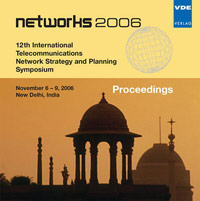Redundancy and Scalability in IMS
Konferenz: networks 2006 - 12th International Telecommunications Network Strategy and Planning - Symposium
06.11.2006 - 09.11.2006 in New Delhi, India
Tagungsband: networks 2006
Seiten: 6Sprache: EnglischTyp: PDF
Persönliche VDE-Mitglieder erhalten auf diesen Artikel 10% Rabatt
Autoren:
Hammer, Manfred; Franx, Wouter (Lucent Technologies, Thurn & Taxis Strasse 10, 90411 Nuremberg, Germany)
Inhalt:
Traditional telecommunication networks are optimised having dedicated network functions at certain locations, taking cost, quality of service, reliability and other technical circumstances into account. Load sharing of spread network functions hardly could be realized. With the IP Multimedia Subsystem (IMS) a totally different approach will be realized. It is based on the IP protocol carrying bearer and signalling/control traffic. While bearer traffic functions still to be optimized with respect to best location, the signalling and control functions of the network could be spread more or less arbitrarily over the network because relatively low traffic between the functions doesn’t impact the optimisation result of the total network too much. This is an additional degree of freedom for assigning such kind of equipment to given locations. It opens up new possibilities for scaling the equipment for total network capacity needs and gives a chance to distribute redundancy geographically, which influences network reliability in a positive way. Moreover, the distributed IMS architecture based on SIP proxy mechanisms provide better means for redundancy and scalability as compared to “classic softswitches” that still follow a nodal architecture. This paper outlines the new flexibility in telecommunication networks by taking an IMS approach and gives some insight into the linkage between scalability and redundancy as well as between capacity needs and network reliability.


